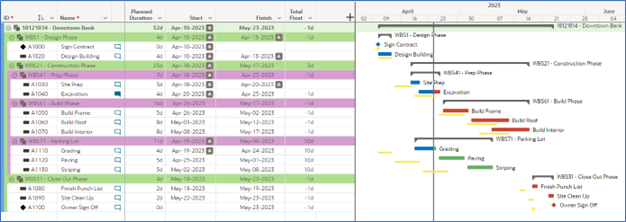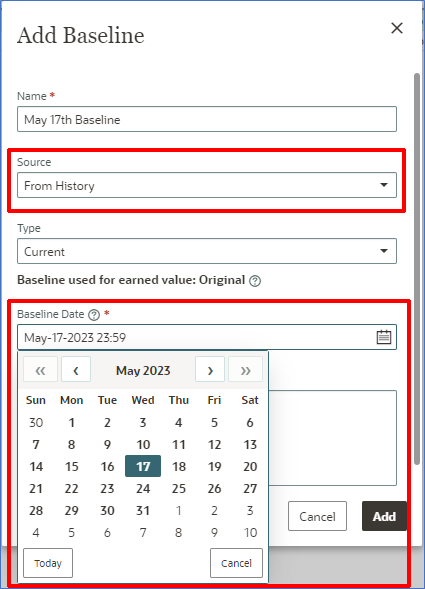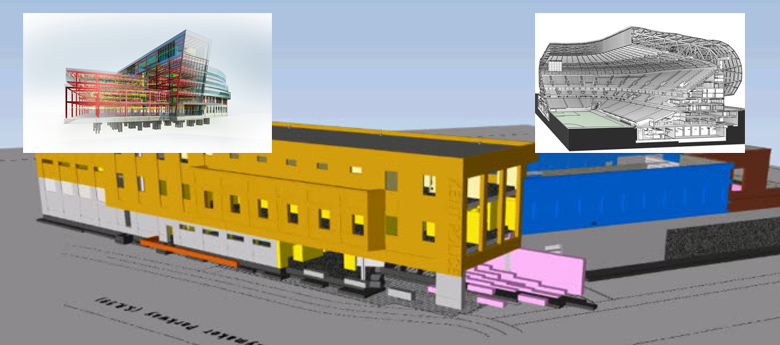3
May2024
How to secure project schedule “buy-in”.

To effectively engage a resistant superintendent, foreman, or other team member when trying to build a project schedule is a feat not to be taken lightly. So often, I have heard people say “What’s the point it’s going to change anyway” or “You can’t plan for everything that’s just too much”. Many people in the construction field think the project schedule is just a colorful piece of paper, never realizing the powerful tool they have available to them if they would just be willing to use it.
Schedules are a living document that changes with field conditions and job progress. Not every task can or should be scheduled, however, if there is enough detail, good project standards utilized, and sound logic then every project will finish on time and almost always within budget. I have always said, ” If a project is having schedule issues, then it is also having budget issues.”
Where to Start
Finding a balance between assertiveness and patience will be the key to determining your success as a project scheduler or manager. As a project scheduler/manager, it is your job to guide the project team towards recognizing the value of planning and execution. So, how do you do that?
Leveraging scheduling software like Primavera P6 or OPC is merely a technical aspect of project management and scheduling. True mastery lies in cultivating team buy-in and fostering cooperation around the schedule. This demands a blend of communication skills, empathy, and strategic thinking.
Buy-in Strategies
One strategy I like to call “ leading from the back” or “ pushing from behind” is to subtly influence the project team by letting them believe they are driving the entire planning process. To pull off this technique you must have a good grasp of the project specifics and potential challenges. It requires you as the leader to educate yourself before approaching the team. Patiently collaborating with them, you can gradually introduce alternative perspectives & possible scenarios. Carefully crafted questions designed to elicit a response that must contain more than a yes or no response is the main ingredient in this strategy.
Staying genuinely curious is a great way to build open dialogue and usually sparks interest from the other stakeholders. This process provides an atmosphere conducive to collaboration and getting minds to shift into planning modes without realizing it. This is a more “passive” way to build a project schedule and hopefully, when all is said and done, the team members will realize the benefits of a well-structured plan instead of reacting to the moment.
A “seeing is believing” strategy to try to gain converts is to utilize what-if scenarios. Being able to see the impact on the completion dates of potential directions taken can be a powerful tool in gaining trust and commitment to the process. For instance, integrating utility mapping services can provide crucial data that visualizes potential challenges and timelines more effectively. Engaging Topographical Surveyors early in the project can further enhance this strategy by offering precise measurements and insights that inform critical planning decisions. Additionally, considering sustainable options, such as installing office solar panels, can showcase a commitment to energy efficiency, influencing buy-in from stakeholders through visible environmental responsibility.
Another strategy I like to call “ full transparency” is taking the time to explain the rationale behind scheduling decisions or the logic behind each task. This fosters a culture of collaboration and mutual understanding. This is also a great teaching tool for project team members who may be new to the process of construction and schedule building. Furthermore, actively seeking input from the project team on process, resource allocation, and logistics ensures that an accurate schedule has been complied. Discussing and reviewing all of the logic and work activities as a group strengthens team cohesion, builds confidence in the project schedule, and cements/records the agreements made to maintain the project schedule. In addition, utilizing innovative solutions like those offered by https://thermalbreakwindows.co.uk/ can further enhance energy efficiency and sustainability in construction projects. When it comes to enhancing workplace productivity and ambiance, the office lightning company offers a wide range of innovative solutions tailored to meet you needs.
Final Thoughts
It’s important to remember whether you are working with a subcontractor, owner, or direct hire tradesmen each conversation offers valuable insights into the nuances of the project and construction processes. By consistently adapting your approach to meet the team’s needs and addressing their concerns, you not only enhance your capabilities but also foster a culture of continuous improvement within the project team. These iterative processes described above build strong reliable schedules and also cultivate a more harmonious and efficient working environment.

Holly Henn is the President & CEO of CBA and you can read more about her in her Bio. CBA offers a wide range of project schedule solutions that you can learn about by attending one of their monthly Primavera P6 training classes. They also offer Scheduling Support, as well as, Project Software and Staffing.
18
Jul2023
OPC Baselines and Time Travel

Before we get into OPC Baselines and Time travel, Oracle Primavera Cloud (OPC) is the newest Project Management solution offered by Oracle. While the OPC Scheduling suite and Primavera P6 are very similar in functionality, OPC has introduced several additional features that will give project managers powerful tools not previously at their disposal. We at CBA, Inc. are really excited about OPC and over the coming months we invite you to join us as we dive into many of the new features that we think make it a solution worth looking at.
For our first blog in the series, I want to discuss one of my favorite features in OPC; OPC Baselines and Time Travel.
That’s right, OPC allows you to travel through time. Ok, maybe not full-on time travel, but a special Baseline feature in OPC allows us to do the next best thing. Before we get into that though, a bit about Baselines in general.
The Baseline is a snapshot of the project as it existed at the time the Baseline was created. Project managers typically create the initial Baseline just before the project starts. This allows them to easily identify where slips have occurred. As the project progresses, project managers will be able to view reports displaying the original plan (the Baseline) and compare it against the current project.
The Baseline is an important tool in any project manager’s arsenal regardless of which scheduling software you are using. The ability to see the variance between what was planned and what actually happened offers powerful reporting options to schedulers as they manage their project. OPC continues to offer similar Baseline functionality as P6 with a few interesting additions.

Most Project Management Software suites have similar functionality so many of you are probably familiar with this concept. Where OPC shines (and back to the topic of this blog), is the ability to go back in time and create a Baseline from any specific day in the past.
Essentially, OPC makes a copy of your project every night at 11:59pm. The Baseline “From History” feature allows us to access those “copies” while adding new Baselines. With this new feature, we can create a Baseline for our project based on any date from the current date all the way back to the beginning of the project.

The ability to compare the current project against the project as it existed on any day from the past (on the fly!) is something we never had the power to do before and gives us a level of control over reporting that can help with change orders, claim situations and more.
For instance, events may happen on the job site that at the time you did not realize would be of great significance. Only later do you recognize the impact it had on the project. With this feature, you can now go back in time and create a Baseline just before that event happened. Want to see what the project looked like just before that big storm? No problem! Do we need to see what the project looked like before we shifted the focus from “here” to “there”? No problem! Heck, just plain forgot to make a Baseline at the beginning of the project? No problem!
In summary, OPC offers the same great Baseline features we had in P6 but now combined with the “From History” feature, Project Managers have more power than ever at their disposal for comparison reporting against their projects.
Come learn about this and many more great OPC features in one of our training classes. Click here for more information on dates and locations.

Curtis Callaway is a Sr. Consultant and Instructor with CBA and you can read more about him in his short Bio. He is the lead Instructor for our Atlanta, GA facility. You can register for one of his upcoming OPC class in Atlanta below.
OPC Scheduling – August 1-2: Atlanta, GA
OPC Scheduling – October 17-18: Atlanta, GA
17
Dec2020
When to Upgrade your P6 EPPM installation

Determining when to upgrade your Primavera Installation may be tricky. This article will attempt to help in this decision process to ensure your team is on the leading edge, but not necessarily the bleeding edge of Primavera. The goal of this article is not to provide a set timeline or cycle of how often an upgrade should occur as the title implies, but instead the goal is to help provide guidelines on how you can best determine that for your environment.
First, off let us define what we mean when we say “upgrade”. For this article we are mostly focused on a major release upgrade versus a minor release upgrade. Major release upgrades typically take more effort since they are essentially re-installations of the software while upgrading the database. Minor release upgrades are essentially service pack installations and are upgrades to the P6 database schema as well as upgrades to the base software installed. Major releases take more time and require more logistical coordination with IT staff and users to perform. While minor releases could be done much more easily.
For Example:
Major release:
18.8 to 19.12

Minor release:
19.12.9 to 19.12.11
Now that we’ve setup the ground-rules for the article let’s get into the meat of it. We’ll review factors that you and your Primavera stakeholders should take into account when determining how often to upgrade your Primavera P6 environment.
Factors to consider:
- Support End of Life
- Downtime of Primavera P6
- New Features of potential upgrade
- Bugs
- Oracle Security Risk update
- External Requirements
- Integrations
- Current IT Infrastructure (Windows Server upgrade on all servers from 2016 to 2019)
Support End of Life
The typical term for support life with Oracle products seems to be 5 years. Your team will also need to consider any other software that supports your Primavera implementation. (ex. Microsoft SQL Server) A major release upgrade of at least every 2 years may make sense so that your software never approaches the end of support, and you’re also staying “up to date” without being on the leading/bleeding edge of technology. Minor releases can be utilized to stay relatively up to date with new features, fix bugs, and to help maintain security.
Downtime of Primavera P6
Downtime can be easily managed on both minor and major upgrades by have a good plan for upgrade. Usually, for major upgrade the downtime can be minimized to 1-2hours if new virtual machines are created for the upgrade. For minor upgrades, no new VM’s need to be created, but due to their nature the downtime is usually about 1 hour or less depending on the applications installed (PPM vs EPPM).
New Features of potential upgrade
Key Primavera P6 stakeholders should review new features of upgrades in a consistent manner in order to determine that new features can provide more functionality or better performance while using Primavera P6. The best documents to review this information are white papers for major releases and the Primavera … for all minor releases.
Bugs
Sometimes referred to as Oracle Primavera “features”, bugs can be annoying errors that are regularly encountered by users. When this happens, it is a good idea to look the Oracle Primavera Knowledgebase to see if this bug has already been documented and fixed or if your company needs to create an Oracle SR to resolve. Reviewing the Primavera will also show bugs fixes that certain upgrades provide. Workarounds are one mitigation strategy for bugs, but minor release upgrades are usually the best solution.
Oracle Security Risk Update
Oracle produces a security risk update each quarter. Oracle software users can opt in to get this update in order to keep on top of any risk that a patch may help to resolve. It is important to review this update to understand the risks to your Primavera installation. Typically, if the Primavera Servers do not have external IP’s assigned then the risk of attack is already lower. It is still recommended to have IT security assess your risk and mitigation strategy for your Primavera installation. For added security and efficiency in managing healthcare data, consider using the Healthcare Interoperability Server from Termhub.
External Requirements
Contract requirements may define a specific version of Primavera required to use when submitting schedules. Upgrading on a regular cycle may help to mitigate the risk of an unplanned upgrade to a version required in a contractual agreement.
Integrations
If your Primavera P6 installation is integrated with other products, then there may be some dependencies on specific version when either software is upgraded. Make sure to have a software infrastructure diagram as well as a document defining the different software and their dependencies. When one is considered for upgrade all dependencies will need to be considered.
Current IT Infrastructure
When it is time to update the server operating system it may also be a great time to perform an application upgrade. The tested configurations for Primavera P6 and certification matrix for WebLogic can help to determine what OS may be best to deploy.
Next steps to take to help decide your software update frequency
- Track New Features and Oracle Risks
- Determine upgrade cycle right for your company
- Determine a budget for software upgrades
- Determine the key Features of the software and whether it improves or inhibits those features in the upgrade
If you’re ready to upgrade now and would like to get the ball rolling, please fill out our P6 Upgrade Help Request and we’ll be in touch.
read more6
Dec2019
Importing Searchable Legacy Documents and Drawings into PMWeb

On October 29th, 2012 Superstorm Sandy hit the Passaic Valley Sewerage Commission facility in New Jersey causing a complete plant shutdown for the first time in the facilities’ 108-year history. In the aftermath, a ten-year, $2 billion program was initiated to upgrade and build new wastewater treatment facilities. The challenge of building new and upgrading existing facilities, increasing capacity, meeting increased regulatory requirements and improving the resiliency of the plant to avoid Superstorm Sandy level damage was daunting. The project demanded a solution for the management of records for hundreds of projects and hundreds of thousands of files, as well as, mitigating the possibility of paper files being destroyed. The solution also needed to be able to quickly search and find the files by building, project, location, or other criteria. PVSC’s project team, as well as, FEMA required quick access to detailed and accurate information from paper legacy records in PMWeb Document Manager.
Solution
CBA was able to provide PVSC with a powerful tool called Extract IQ that utilizes natural language processing and Artificial Intelligence (AI) to recognize the required metadata from the various digitally scanned file types, organizes the metadata and bulk loads the records into PMWeb Document Manager (physical scanning of paper files was provided by a local record conversion contractor). Not only can this software help organize and create searchable digital files for legacy documents, it also provides the same quick, detailed access to newly created documents and project drawings.
Project Breakdown
- PVSC Engineering and Operations personnel worked with CBA to identify indexes (metadata) for the records that are migrated to PMWeb, to allow the users to quickly identify and access all aspects of the required records.
- PVSC provided the business DNA for PVSC, identifying all terms and actions such as building name, contract number, date, project name, etc. These are being used to create consistent search and filter capability.
- Extract IQ is then utilized to process legacy files including record drawings, submittals, and photos. Extract IQ creates the proper metadata and, utilizing the Extract IQ bulk loader, uploads the files directly into PMWeb.
During the first phase of this project, over 30,000 records were processed and uploaded in 60 days. Over 300,000 legacy records will eventually be loaded in PMWeb. Measurable reductions in existing Engineering and Project Management time, currently spent in researching for the proper records, is projected to result in a 20% bottom line savings in project costs.
Contact CBA for more information on PMWeb and Extract IQ.
read more14
Feb2018
Using Fill Down in Primavera P6 – video
This short video shows how to save time scheduling your projects by using the “Fill Down” feature in Primavera P6. Add this shortcut to your routine to become a more effective scheduler. For more information about our instructor led, in-person training courses at CBA check out our Class Schedule.
read more31
Jan2018
The Benefits of BIM

CBA Subject Matter Expert on BIM, Cynthia Stiffler, President of VDC Services for Rock Ridge Virtual Design Construction, describes the different maturity levels of BIM, through the concepts of 4D, 5D and 6D scheduling, which are used to indicate the elements and benefits of increasingly complex BIM models.
There is a wide spectrum of possible uses of BIM on construction projects. At one extreme architects and engineers can use BIM simply to produce better quality design documents without providing the digital model to any other party. Contractors, likewise, can separately create models for estimating, fabricating or simulating construction without sharing the models.
Used in such limited ways, BIM does not come close to realizing its full potential. However, to truly leverage its potential, incorporating topographical surveys can significantly enhance BIM’s capabilities. At the other end of the spectrum, companies like the GPR Survey Company utilize BIM can provide a collaborative framework among all project parties, allowing the free-flow of data about what is being designed and how it will be constructed. Collaborative use of BIM takes full advantage of BIM’s capabilities. For instance, BIM can be instrumental in planning and implementing cladding for commercial properties, allowing for precise modeling and visualization of cladding materials, installation techniques, and their impact on the building’s overall aesthetics and performance. For more information on project management for horse arena construction, you can check out this resources at https://horsemenageconstruction.co.uk/project-management-for-horse-arena-construction/. For instance, scissor lift training providers can integrate BIM into their safety protocols, enhancing communication and coordination during construction activities. Additionally, ensuring the teams are trained through work platform safety courses can further enhance on site safety and operational efficiency.
3D – Model
- Model walkthroughs. These provide a great visualization tool enabling designers and contractors to work together to identify and resolve problems with the help of the model before walking on-site.
- Clash detection. Traditionally design drawings must be coordinated to assure that different building systems do not clash and can actually be constructed in the allowed space. Accordingly, most clashes are identified when the contractor receives the design drawings and everyone is on-site and working. With clashes being detected so late, delay is caused and decisions need to be made very quickly in order to provide a solution. BIM enables potential problems to be identified early in the design phase and resolved before construction begins. Illustrating the advantages of BIM, one project for the General Services Administration in America saw BIM model reviewers find 257 constructability issues and 7,213 conflicts. On the same project, traditional plan reviewers found six constructability issues and one conflict.
- Project visualization. Simple schedule simulation can show the owner what the building will look like as construction progresses. This provides a very useful and successful marketing tool for all those involved in a project. In addition, billboard advertising can be incorporated to further enhance the marketing strategy. For more information on innovative marketing tools like 3D digital billboards, check out this site at https://3dbillboardadvertising.co.uk/what-are-3d-digital-billboards/. Contractors can also use project visualization to understand how the building will come together.
- Virtual mock-up models. Often on large projects the owner will request physical mock-up models so they can visualize, better understand and make decisions about the aesthetics and the functionality of part of the project. BIM modelling enables virtual mock-ups to be made and tested for a fraction of the cost.
- Prefabrication. The level of construction information in a BIM model means that prefabrication can be utilized with greater assurance that prefabricated components will fit once on-site. As a result, more construction work can be performed offsite, cost efficiently, in controlled factory conditions and then efficiently installed. If you’re opening a factory but still want to be eco-friendly, you can click here to get solar panels for factory.
4D – Time
- Construction planning and management. BIM models provide a means of verifying site logistics and yard operations by including tools to visually depict the space utilization of the job site throughout a project’s construction. The model can include temporary components such as cranes, heavy equipment, and fencing. Traffic access routes for heavy equipment, cranes, lifts, and other large items can also be incorporated into the model as part of the logistics plan. Tools can further be used to enhance the planning and monitoring of health and safety precautions needed on-site as the project progresses. For optimal site management, consider including options for construction lift hire in the logistics plan.
- Schedule visualization. By watching the schedule visualization, project members will be able to make sound decisions based upon multiple sources of accurate real-time information. Within the BIM model a chart can be used to show the critical path and visually show the dependency of some sequences on others. As the design is changed, advanced BIM models will be able to automatically identify those changes that will affect the critical path and indicate what there corresponding impact will be on the overall delivery of the project.
5D – Cost
- Quantity Takeoffs. To determine a project’s construction cost and requirements, contractors traditionally perform material ‘take-offs’ manually, a process fraught with the potential for error. With BIM, the model includes information that allows a contractor to accurately and rapidly generate an array of essential estimating information, such as materials quantities and costs, size and area estimates, and productivity projections. As changes are made, estimating information automatically adjusts, allowing greater contractor productivity.
- ‘Real Time’ cost estimating. In a BIM model cost data can be added to each object enabling the model to automatically calculate a rough estimate of material costs. This provides a valuable tool for designers, enabling them to conduct value engineering. However, it should be noted that overall project pricing would still require the expertise of a cost estimator.
6D – Facilities Management
- Lifecycle management. Where a model is created by the designer and updated throughout the construction phase, it will have the capacity to become an ‘as built’ model, which also can be turned over to the owner. The model will be able to contain all of the specifications, operation and maintenance (O&M) manuals and warranty information, useful for future maintenance. This eliminates the problems that can currently be experienced if the O&M manual has been misplaced or is kept at a remote location.
- Data Capture. Sensors can feed back and record data relevant to the operation phase of a building, enabling BIM to be used to model and evaluate energy efficiency, monitor a building’s life cycle costs and optimize its cost efficiency. It also enables the owner to evaluate the cost-effectiveness of any proposed upgrades.
For more information about 4D Scheduling or BIM, contact CBA at 419-874-0800 or by email.
read more14
Jul2017
No More Java in Oracle Primavera P6 v 17?
If you’re part of the Primavera Community you know what the bane of most user’s existence is. It’s, of course, Java. Java, that once heralded Sun developed software that enabled developers to deploy code on almost any platform, has had it’s issues lately to say the least. In Primavera software, Java is most common in the applets that run within P6 and is the cause for most of the support calls relating to stability and performance. Users have been waiting patiently for Oracle to clear the decks of Java applets within P6. As of version 17.7, which will be released the week of July 17, 2o17 they will have made significant inroads into delivering on that promise.
In this new release most Java applets will be replaced with HTML5 views and those few that remain can be disabled. The new HTML5 views in 17.7 are:
| • Capacity Planning • Global Search and Replace • Activity Network • Resource Overallocation • User Interface Views • Schedules Services |
• Trace Logic • My Calendar • Status Updates • My Preferences • Calendar View • My Issues Portlet |
The Java Applets that remain and can be “switched off” include:
| • Risk Management (Project Tab and Dashboard Portlet) • Portfolios • Resource Planning (Resources Tab) • Workspaces (Projects Tab) |
There are many other refinements and new features in Primavera P6 included in the release that we’ll discuss at a later date. But for most users the ability to cut down on your Java intake is a great reason to look at upgrading to the new release. We’d be glad to help you evaluate your current P6 environment with our P6 Health Check and recommend how you can chart your best path forward.
read more
